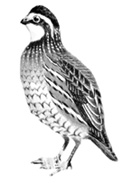
Bobwhite
Earth Journal:
Bobwhite
Some sounds of summer are mostly remembered.
Just as much as crabbing, swimming, boating and visiting relatives on the South and Patuxent Rivers were part of my summers growing up, so was hearing the call of the bobwhite on still, steamy summer afternoons.
Now it seems I have to travel all the way down to my sister's home in southern Alabama to hear that singular call.
In the rural south, quail still thrive in a countryside of cotton and peanut fields, bordered by stands of long leaf pine and fragrant mimosa.
Here in Maryland, as agricultural lands shrink and development encroaches, some sounds of summer, like the bobwhite, are mostly remembered.
I haven't always heeded life's calls that sometimes beckon me from a state as lazy as a child's summer nap. But somehow, involuntarily, I've always returned the sweet summons of the bobwhite quail each time it calls. I did so again as it echoed across peaceful Alabama fields near my sister's home. But beauty is always easier to follow than duty, I suppose.
The truth is, I've never actually seen this small, plump bird the size of a robin. But I sure remember the pure sound of its whistle piercing the air like cracking whip. Seeing this small game bird is a challenge anyway, with its mottled brown plumage that makes for effective camouflage. And of course seeing is not always believing; it's that distinctive call that's engrained in our senses that we recognize.
Living by the Bay for seven years now, I've heard the bobwhite but one season. DNR's bird expert Glenn Therres told me why. "Bobwhite are resident birds. They don't migrate," he says. "They either prosper or decline."
In Maryland, they are declining.
Though Therres lacks the exact figures he has for our expanding eagle population, he has the reason. "Bobwhite are birds of the field; their habitat is the forest edge, associated with agricultural lands," Therres explains.
In the past some fields were left fallow, inviting nesting in the grasses between field and forest. Goldenrod and broom sedge added to the light cover bobwhite prefer. Now, most agricultural lands - and those are fewer each year - are actively farmed. To help, DNR pushes growing warm-season prairie grass-like crops to give the quail cover for nesting opportunity.
Inhabiting the "edge" between field and forest (and us), bobwhites are truly on the edge of life, with one of the highest rates of decline among birds. Therres describes the bobwhite as "pretty vocal with a sound that travels far over field and water." Perhaps the word hasn't traveled far enough, so that we are in danger of losing the uncommon call of this bird of field and summers past.
Has the bobwhite called you this summer? Let New Bay Times know.
-M.L. Faunce
| Back to Archives |
VolumeVI Number 24
June 18-24, 1997
New Bay Times
| Homepage |